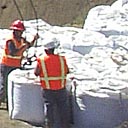Organoclay > ACM - Activated Clay Media
OrganoClay - Background and Description
The Nature of Organoclays
As the organoclay is introduced into water, the quaternary amine is activated and extends perpendicularly off the clay platelets into the water. A chlorine or bromine ion is loosely attached to the carbon chain. Since the sodium ions that were replaced by the nitrogen are positively charged, they bond with the chlorine ion, resulting in sodium salt that is washed away. The result is a neutral surfactant with a solid base, which is the organoclay. The hydrophilic end of the amine dissolves into the oil droplet because "like dissolves like," thus removing that droplet from water. Because the partition reaction takes place "outside" of the clay particle (in contrast to adsorption of oil by carbon, which takes place inside its pores), the organoclay does not foul quickly. Organophilic clay can function is as a prepolisher to activated carbon, ion exchange resins, and membranes (to prevent fouling), and as a post polisher to oil/water separators, dissolved air flotation (DAF) units, evaporators, membranes, and skimmers. Organophilic clay powder can be a component or the main staple of a flocculent clay powder. They are excellent adsorbers for the removal of oil, surfactants, and solvents, including methyl ethyl ketone, t-butyl alcohol (TBA), and others. Application Environmental applications of Organophilic clays include groundwater cleanup at old disposal sites and underground storage tank sites as well as the treatment of landfill leachates. Industrial applications include air compressors, cooling water, deburring and metal finishing, gas compressors, boiler blow-down, boiler feed water, metal casting, general manufacturing process water, water produced at oil well drilling sites, and stormwater. Most applications to date have been in groundwater remediation at US Superfund sites, underground storage tank sites, landfill leachate cleanup, and de-watering of contaminated sites during construction. |




